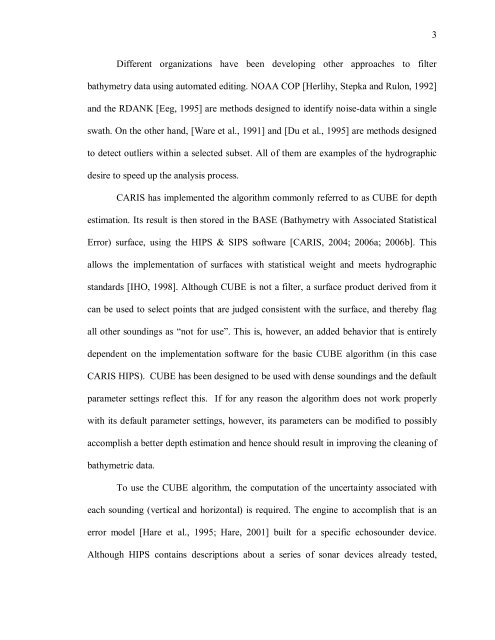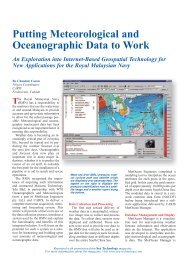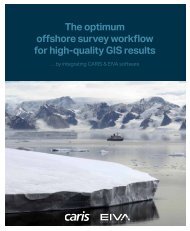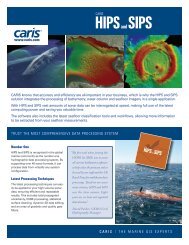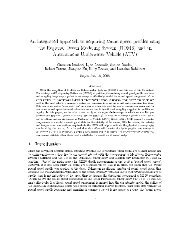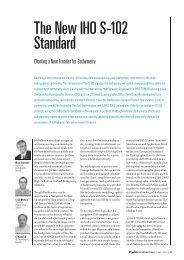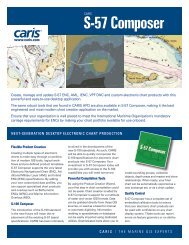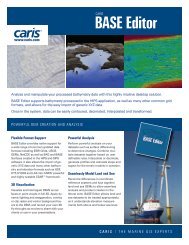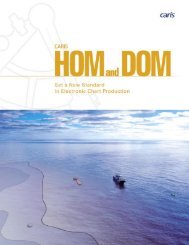Tuning the CARIS implementation of CUBE for Patagonian Waters.pdf
Tuning the CARIS implementation of CUBE for Patagonian Waters.pdf
Tuning the CARIS implementation of CUBE for Patagonian Waters.pdf
Create successful ePaper yourself
Turn your PDF publications into a flip-book with our unique Google optimized e-Paper software.
Different organizations have been developing o<strong>the</strong>r approaches to filter<br />
bathymetry data using automated editing. NOAA COP [Herlihy, Stepka and Rulon, 1992]<br />
and <strong>the</strong> RDANK [Eeg, 1995] are methods designed to identify noise-data within a single<br />
swath. On <strong>the</strong> o<strong>the</strong>r hand, [Ware et al., 1991] and [Du et al., 1995] are methods designed<br />
to detect outliers within a selected subset. All <strong>of</strong> <strong>the</strong>m are examples <strong>of</strong> <strong>the</strong> hydrographic<br />
desire to speed up <strong>the</strong> analysis process.<br />
<strong>CARIS</strong> has implemented <strong>the</strong> algorithm commonly referred to as <strong>CUBE</strong> <strong>for</strong> depth<br />
estimation. Its result is <strong>the</strong>n stored in <strong>the</strong> BASE (Bathymetry with Associated Statistical<br />
Error) surface, using <strong>the</strong> HIPS & SIPS s<strong>of</strong>tware [<strong>CARIS</strong>, 2004; 2006a; 2006b]. This<br />
allows <strong>the</strong> <strong>implementation</strong> <strong>of</strong> surfaces with statistical weight and meets hydrographic<br />
standards [IHO, 1998]. Although <strong>CUBE</strong> is not a filter, a surface product derived from it<br />
can be used to select points that are judged consistent with <strong>the</strong> surface, and <strong>the</strong>reby flag<br />
all o<strong>the</strong>r soundings as “not <strong>for</strong> use”. This is, however, an added behavior that is entirely<br />
dependent on <strong>the</strong> <strong>implementation</strong> s<strong>of</strong>tware <strong>for</strong> <strong>the</strong> basic <strong>CUBE</strong> algorithm (in this case<br />
<strong>CARIS</strong> HIPS). <strong>CUBE</strong> has been designed to be used with dense soundings and <strong>the</strong> default<br />
parameter settings reflect this. If <strong>for</strong> any reason <strong>the</strong> algorithm does not work properly<br />
with its default parameter settings, however, its parameters can be modified to possibly<br />
accomplish a better depth estimation and hence should result in improving <strong>the</strong> cleaning <strong>of</strong><br />
bathymetric data.<br />
To use <strong>the</strong> <strong>CUBE</strong> algorithm, <strong>the</strong> computation <strong>of</strong> <strong>the</strong> uncertainty associated with<br />
each sounding (vertical and horizontal) is required. The engine to accomplish that is an<br />
error model [Hare et al., 1995; Hare, 2001] built <strong>for</strong> a specific echosounder device.<br />
Although HIPS contains descriptions about a series <strong>of</strong> sonar devices already tested,<br />
3


